Art historians generally define Ancient Greek arts as the art produced in the Greek-speaking world from about 1000 BC to about 100 BC. Greek artists first established mimesis (imitation of nature) as a main principle of art. The Ancient Greece Arts is usually divided stylistically into four periods: Geometric, Archaic, Classical, and Hellenistic.
Ancient Greek artifacts
The Ancient Greek artifacts were highly influenced by the local religion and vividly depicted highly influenced by local religion and have a vivid depiction of its gods and mythology.
Although the Greek world was divided politically into fragmented city-states or poleis, they shared a common language, religion, and culture and have left a mark on their art and artifacts.
Their famed nude male torso statues mainly depicted their gods, their majestic form accurately showing their emotions and actions bringing awe to the one watching.
What is the origin of Greek art?
Ancient Greek art has its origins in the Pre-Greek Cycladic and Minoan civilizations which had been influenced by the art and traditions of Ancient Egypt.
The art was also influenced by the philosophy of its time and had a big role in producing the art forms. They had a different notion of color than modern ones. It portrays the philosophical conflict of those times with people like Plato believing in a perfect imitation while Aristotle believed in art representing inner essence.
What was Ancient Greek art known for?
Ancient Greek is famed for its famed naturalistic but also idealized nude male figurines. It put great emphasis on the importance and achievements of human beings. It is especially known for its temples dedicated to Gods like the ones still surviving in modern-day Athens.
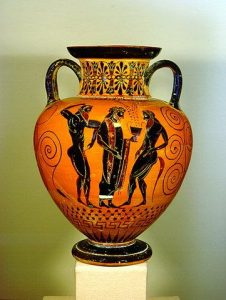
The Dark Ages (1100 – 750 B.C.)
During the Dark Age, Artisans in Athens produced an abstract style of painted pottery called Protogeometric (meaning “first geometric”). The precision of the painting on this pottery foretells the character of later Greek arts. Around 800 B.C., the Hellenic civilization began to arise.
The last 2 centuries of the Dark Age, are called the Geometric period. That refers to a primarily abstract style of pottery decoration of the time. The Greeks probably adapted Phoenician alphabet at the same time, (around 800 B.C).
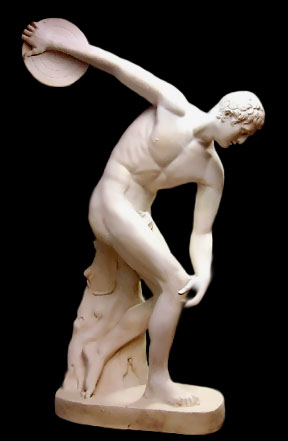
The Archaic Period (750-500 B.C.)
In the Archaic period, statues were never intended to be representations of actual individuals. They were depictions of an ideal – beauty, piety, honor or sacrifice. They were always depictions of young men, ranging in age from adolescence to early maturity, even when placed on the graves of (presumably) elderly citizens. Kouroi were all stylistically similar. Gradations in the social importance of the person commissioning the statue were indicated by size rather than artistic innovation.

Greek Art Painting
This is the period when monumental stone sculpture, vase painting, and other developments were seen represented as Greek ideas. As each community attempted to establish itself as culturally superior, Monumental building programs became part of the competition. In this period, Kouros and kore statues were created.
These stylized figures of young men and maidens express the birth of a specifically Greek artistic obsession – the idealization of the human figure. The art of vase-painting reached a level of artistic and technical excellence.

The Classical Period (480-338 B.C.)
In the Classical period, there was a revolution in Greek statuary, usually associated with the introduction of democracy and the end of the aristocratic culture associated with the kouroi. The Classical period saw changes in both the style and function of sculpture.
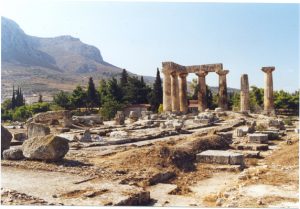
Greek Arts sculpture
Greek sculptors had learned to represent the human body naturally and easily, in action or at rest. They were portraying gods and their best sculptures achieved almost godlike perfection in their calm, ordered beauty. Poses became more naturalistic and the technical skill of Greek sculptors in depicting the human form in a variety of poses greatly increased.
The Hellenistic Period (338-31 B.C.)
This represents the shift from a culture dominated by ethnic Greeks, to a culture dominated by Greek-speakers of whatever ethnicity, and from the political dominance of the city-state to that of larger monarchies.
Thus Ancient Greek Arts became more diverse and more influenced by the cultures of the peoples drawn into the Greek orbit. In the view of most art historians, it also declined in quality and originality; this, however, is a subjective judgment which artists and art-lovers of the time would not have shared.
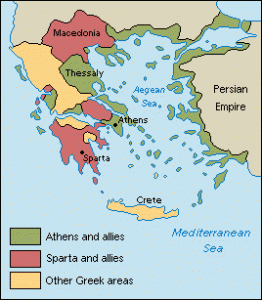
Hellenistic Greek Art
In the Hellenistic Greek art, people sought to portray the inner emotions and details of everyday life instead of the heroic beauty. The style changed from godlike serenity to individual emotion and from the dramatic to melodramatic pathos, using dramatic poses and theatrical contrasts of light and shade playing over figures in high reliefs.
One characteristic of these sculptures was that they showed extreme expressions of pain, stress, wild anger, fear, and despair. The first Theaters were built in the Hellenistic Period. Corinthian columns began to be more common in this period.
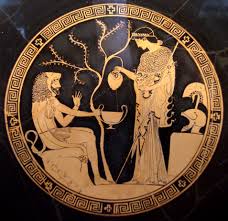
Ancient Greek artist
Ancient Greek was a place which produced one of the greatest artist the world has produced and some of the famous artists were:
- Agatharchus: He was a 5th-century painter who brought perspective and illusion to the creation of scenic painting, and also showed the position of objects against the sun along with their shadows.
- Apollodorus: He was another painter whose subject was mainly gods and goddesses and was known for his masterful presentation of shadow, where his style of painting was known as ‘skiagraphia’ or shadow painting.
- Phidias: He was a sculptor from the city of Athens. He constructed a 40 feet tall statue of Athena and also another statue of Zeus at Olympia made of ivory and gold.
-
Praxiteles: He is credited for sculpting a female figure in a life-sized statue for the first time. He painted both God and men and has another famous sculpture of God Etod with a sad expression.
- Polygnotus: He is famed for his painting on the walls of Athens depicting the siege of Troy. Some of his paintings were even preserved on the walls of the Acropolis in Athen.
What are the 5 most important artworks of ancient Greece?
- The Pergamon Altar: This sculpture features a furious depiction of the scenes in a war during the classical period and is full of passion and psychological drama.
- The Riace bronze statue: This is one of the rare original bronze statues remaining from Ancient Greece which was found from the sea in Southern Italy and portrays a majestic projection of a nude male figure.
- Marble metope from the Parthenon: This portrays the most common theme of violence among the Greek artists and shows a mythic image from the Trojan war that depicts the dynamic energy from the fighting scenes.
- God of the sea, Zeus or Poseidon: Another bronze figure found from the sea around Greece conveys a scene where a God, Zeus or Poseidon is shown hurling a thunderbolt, charged with divine power but all in all human in presentation.
- The Siren Vase: This vase brilliantly portrays the tension of Odysseus who is in bondage, in a state of agony, and his head in a raised position to listen. This refers to the myths of the sirens who used to lure sailors to their deaths.
Which is the most famous Ancient Greek sculpture?
Ancient Greece has many excellent sculptures which have survived even today. Out of the most famous sculpture, we can see the Pentelic marble sculpture, Parthenon Frieze which was created to depict the upper part of Parthenon’s naos. It was almost 160 meters in its original form but only 128 meters have survived. The majority of it is preserved in the British Museum and some in the Acropolis Museum in Athens.
What makes Greek art unique?
The unique thing about the Ancient Greek arts was the breaking away from the artistic conventions prevailing across civilizations, and portraying an idealized form of the human body bringing out qualities like poise, mood, and grace to make lifeless materials look like life-like figures. The perfection achieved by the Greek sculptors in portraying the human body still continues to inspire modern artists.
Why is ancient art Greek important?
Greek architecture has influenced art and architecture over generations. Ancient Greek art and architecture brought in the concept of using geometry and abstract works in sculptures. The accuracy by which they created human anatomy in their statues is still studied today as the realism it portrayed is just extraordinary. The late Hellenistic period portrayed the artist’s emotions through their art. Greek art has formed the foundation of Western art and architecture.
It also gives many imagery of events that have helped historians to construct the history of Ancient Greece. They mainly portrayed their bravery in battles which has helped us recognize the wars fought in those times.
Greek art and architecture have a lasting influence on its simplicity and reasonableness on the history of Western civilization and Ancient Greek Arts. Greeks stated many of permanent themes, attitudes, and forms of Western culture which can be even in buildings like the Capitol Hill of USA and also other western country public buildings.